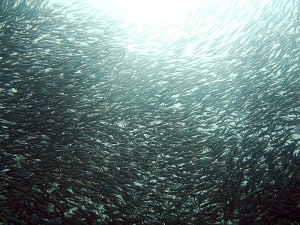
By: Amada Froelich,
Prophesied by researchers last year, the inevitable has happened in Canadian waters: Sardine fleets returned with no fish this month. The loss for the western Canadian’s fisheries, normally worth CAN$32 million (US$30.7 million), still took many by surprise.
Sardines still exist off the US pacific coast, but the vanishing of the Canadian fish is part of a process which means they could all disappear for decades, says Juan Zwolinski of the University of California at Santa Cruz.
Pacific sardine populations normally fluctuate with water temperature, but colder water means fewer fish. History records that temperatures last fell in the 1940’s, but as heavy fishing continued, the stocks were devastated and fishing was ended until sardines returned when waters warmed in the 1980’s.
Zwolinski, the researcher who has tracked the population over the last century, believes history is repeating itself. “We think this is set to happen again.” He has found that sardines have reproduced less since waters cooled in the 1990’s. It seems now almost all eggs come from a fish born a decade ago, which are nearly gone.
What’s even more chilling, acoustic results show that the fish have become smaller over the past decade, partly because of the colder water. This is a big problem: the fattest sardines migrate farthest north, so the shrinking fish may help explain Canada’s shortage. It’s shown smaller fish also reproduce less.
Despite all of this, Canada continues to up their quotas. Deemed unsustainable for a variety of reasons, Alec MacCall of the National Oceanic and Atmospheric Administration (NOAA) speaks about why attention needs to be given to this industry shock: “These natural boom and bust cycles make all sardine fisheries fundamentally unsustainable. There can be periods of decades when no fishing should be allowed since reproduction cannot even replace the parental stock.”
Because fishermen need to earn a living, too, it’s almost impossible to ‘turn off’ a fishery. However, the US limits catches to just 15 percent of the stock, and tries to maintain the boom and bust by cutting quotas when waters cool.
Although better than Canada’s approach, Zwolinksi fears the US has not cut quotas enough, as managers do not take account of other factors like the breeding condition of adult fish. In effect, even the US’s small catches may be too large.
An unfortunate crisis for the fishing industry, the occurrence serves as a wake-up call for all industries, as without proper respect and care given to the environment, it’s likely other populations of wildlife will also decrease.
Sources:
Canadian Fishing Management Plan


